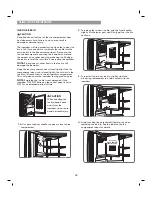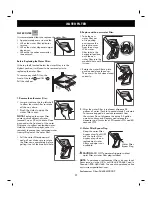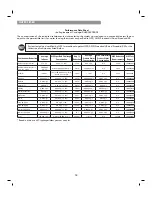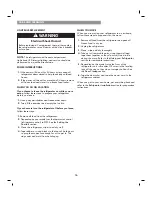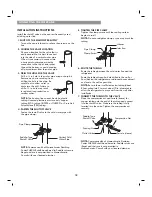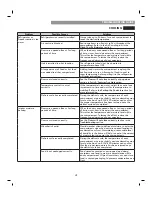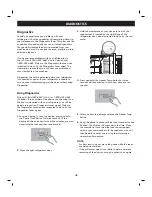
35
CARE AND CLEANING
WARNING
Explosion Hazard
Use non-
fl
ammable cleaner. Failure to do so can result
in
fi
re, explosion, or death.
Both the refrigerator and freezer sections defrost
automatically; however, clean both sections about once a
month to prevent odors. Wipe up spills immediately.
GENERAL CLEANING TIPS
Unplug refrigerator or disconnect power.
•
Remove all removable parts, such as shelves, crispers,
•
etc. Refer to sections in
Using Your Refrigerator
for
removal instructions.
Use a clean sponge or soft cloth and a mild detergent
•
in warm water. Do not use abrasive or harsh cleaners.
Hand wash, rinse and dry all surfaces thoroughly.
•
Plug in refrigerator or reconnect power.
•
EXTERIOR
Waxing external painted metal surfaces helps provide
rust protection. Do not wax plastic parts. Wax painted
metal surfaces at least twice a year using appliance wax
(or auto paste wax). Apply wax with a clean, soft cloth.
For products with a stainless steel exterior, use a clean
sponge or soft cloth and a mild detergent in warm water.
Do not use abrasive or harsh cleaners. Dry thoroughly
with a soft cloth.
INSIDE WALLS (allow freezer to warm up so
the cloth will not stick)
To help remove odors, you can wash the inside of the
refrigerator with a mixture of baking soda and warm
water. Mix 2 tablespoons of baking soda to 1 quart of
water (26 g soda to 1 liter water.) Be sure the baking soda
is completely dissolved so it does not scratch the surfaces
of the refrigerator.
DOOR LINERS AND GASKETS
Use a clean sponge or soft cloth and a mild detergent
in warm water. Do not use cleaning waxes, concentrated
detergents, bleaches, or cleaners containing petroleum on
plastic refrigerator parts.
PLASTIC PARTS (Covers and Panels)
Use a clean sponge or soft cloth and a mild detergent
in warm water. Do not use window sprays, abrasive
cleansers, or
fl
ammable
fl
uids. These can scratch or
damage the material.
CONDENSER COILS
Use a vacuum cleaner with
an attachment to clean the
condenser cover and vents.
Do not remove the panel
covering the condenser
coil area.
CAUTION:
While cleaning the inside, do not spray
water.


